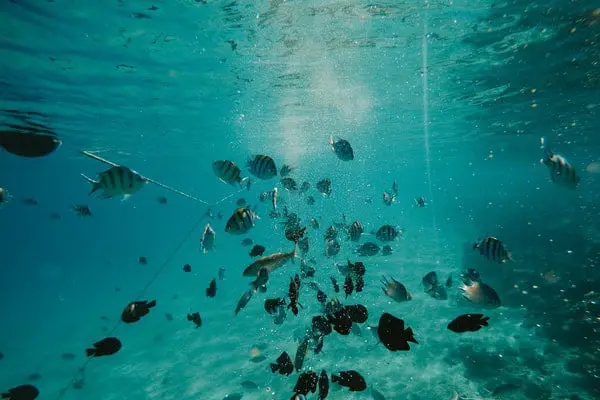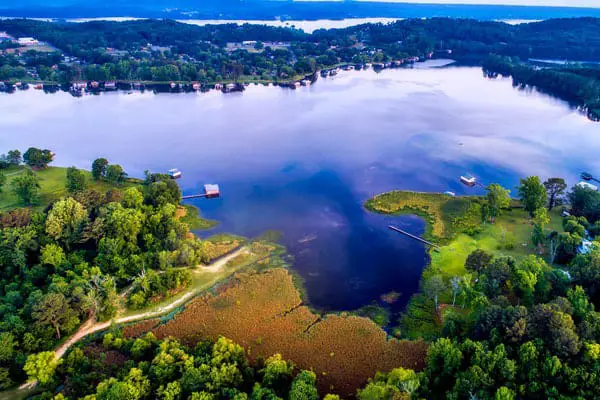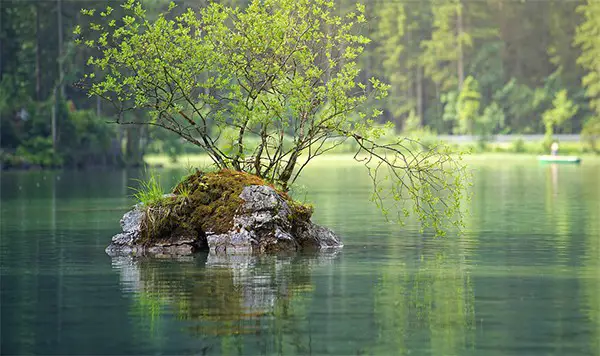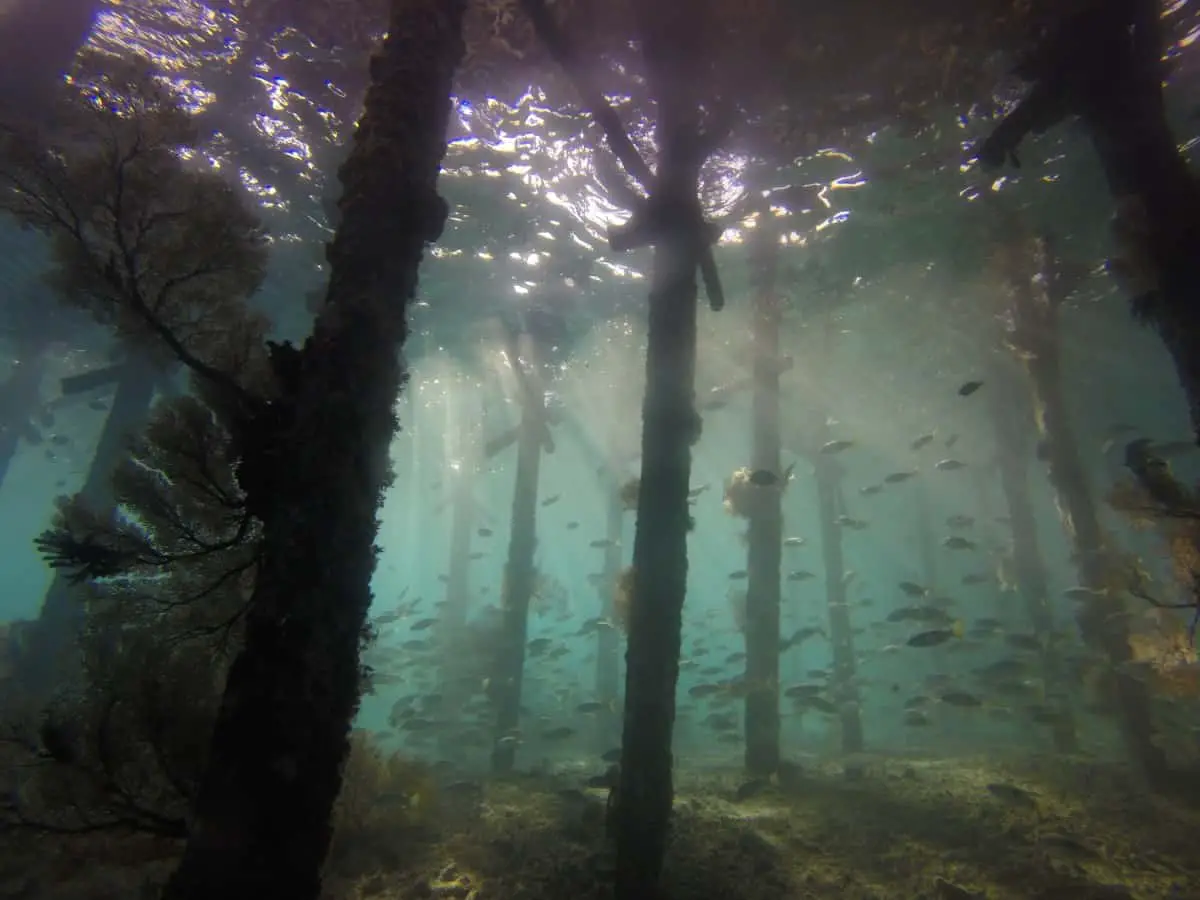Table of Contents
Image from Pxhere
Just 60 feet beneath the surface off of the coast of Alabama lies one of the Gulf of Mexico’s best-kept secrets. Appropriately dubbed the Underwater Forest, it is a perfectly preserved cypress forest that dates back thousands of millennia. This ancient relic remained hidden beneath 10 feet of sediment on the floor of the Gulf until it was revealed to modern scientists by the intense oceanic turmoil produced by Hurricane Ivan in 2004.
What Is Alabama’s Underwater Forest?
The Underwater Forest is an impeccably preserved forest of cypress trees that once covered a swampy valley near what was then the coast. Scientists believe that the forest stood on what once was an island in the swampy coastal Gulf waters. Evidence shows that sea levels at the time rose so quickly that the forest was covered in a thick layer of mud and then swallowed up by the rising ocean.
The mud contained little to no oxygen, which is required for decomposition, so the forest was protected from the salt water’s eroding effects and decomposing bacteria. In fact, the trees are so well preserved that they still ooze sap when they’re cut!
The forest was able to exist in the first place because, during one of Earth’s many Ice Ages, a significant portion of the planet’s water was frozen in massive glaciers, putting the sea level hundreds of feet lower than it is now. Scientists speculate that the area has ranged from 400 feet above sea level to 100 feet below sea level in the last 60,000 years. This means the shore of modern day Alabama was about 10 more miles out to sea than it is now. In these swampy coastal regions, cypress forests like the one that comprises the Underwater Forest grew in abundance.
How Old Is The Underwater Forest?
The Underwater Forest is estimated to be about 60,000 years old. It is a particularly unique and exciting scientific discovery because it is the oldest and largest preserved forest found to date. A team of divers set about collecting samples of the trees for dating purposes, and some samples were so old scientists could not use radiocarbon dating. Newer samples proved to be from 42,000 – 45,000 years old. Cypress trees normally decompose over a period of about 10,000 years.
More Amazing Facts
Not Much Has Changed

image source: pexels
Amazingly, the forest and the surrounding area is still largely intact. From images of the Underwater Forest, those familiar with cypress tress will recognize the hallmark “knees” that surround the trees’ trunks. These “knees” are thought to help the trees stand upright in the soft mud that they call home. Astonishingly, the knees seem to have been serving the same purpose underwater all these thousands of years, as the trees are still firmly rooted and upright.
There is also evidence that a river wound through the forest. The riverbank, though inhabited now by vastly different creatures than it was an eon ago, is still intact and easily recognizable today. The trees could give scientists clues about the types of insects that lived during the forests’ time and other plant life that may have been growing in the vicinity.
Paleontologists will be able to glean information about rainfall and the Earth’s climate at the time the forest was thriving. Very little is known for sure about the Ice Age Earth experienced 60,000 years ago, and this forest contains some of the only preserved plant life known to have survived to modern times.
Discovery
Hurricane Ivan was a Category 4 storm that ripped through the Gulf of Mexico and devastated regions of the Gulf Coast in 2004. It brought 140mph winds and the largest waves ever measured. It is to date one of the worst storms to reach the Gulf in a century. The storm passed directly over the location of the then-buried Underwater Forest, and the rushing currents unearthed the paleontological treasure.
The exact location of the forest was actually discovered by Alabama locals. Fishermen off the coast of Mobile, Alabama found a spot teeming with fish, but could not explain what attracted the fish to the area. No significant structures were showing up on their boat’s depth finder. They suggested dive shop owner Chas Broughton investigate, and what he found, of course, was the Underwater Forest. Broughton had been diving in the Gulf for over 25 years and reported that he had never seen anything like the forest.
Protecting the Underwater Forest

image source: pexels
Broughton and the fishermen went to great lengths to protect the secret of the ancient forest’s location. He finally disclosed the coordinates to environmental journalist and Alabama resident Ben Raines in 2012. Raines invited several scientists to conduct research on the forest and wrote articles about their findings. When diving and conducting research, the team uses the same techniques developed for research in extremely fragile coral reef environments.
They are careful not to disturb the floor and use only noninvasive instruments for surveying and gathering data. The team also worked to make the forest a national marine sanctuary to protect it from potential exploitation schemes.
After announcing the discovery of the forest through articles published online, Raines received several troubling inquiries from salvage companies who were interested in harvesting the ancient wood for sale as commodities such as coffee tables and guitars. Only scientists were given access to the site, and samples have been analyzed at Louisiana State University and the University of Southern Mississippi.
Clues About the Future

image source: pixabay
The discovery of the Underwater Forest has contributed to society’s current conversation about climate change. The Earth has gone through similar climate changes before, and the discovery of the forest could be a peek at the future of some of our current coastal lands as sea levels continue to rise. Evidence suggests that the trees died very quickly, and scientists are working to piece together how the extremely rapidly rising sea may have contributed to their demise.
There are two main theories about how the trees may have come to be buried.
According to Raines, the forest could have been suddenly covered in a massive storm, such as a hurricane. Since sand moves so quickly, this is possible and has been known to happen before.
His second theory is that the area flooded quickly and massively, and sea levels consequently rose high enough to swallow up the trees. This is very important and timely research, as some estimates show that if today’s sea levels continue to rise at the present rate, coastal communities will be experiencing chronic flooding as early as the end of this century.
A Thriving Ecosystem
Since being revealed by the near-100-feet-tall waves created by Hurricane Ivan, the Underwater Forest has become the foundation of a vibrant ecosystem. The concentration of life in the forest is much more consistent with that of a coral reef, which is what originally intrigued the locals that discovered it. Divers have observed sharks, sea turtles and thousands of fish swimming between the ancient trunks. Anemones and sponges also call this freshly unearthed reef environment home. The extent to which this habitat is thriving is unique in itself, considering that the rest of the floor of the Gulf is mostly sandy desert.
The Future of the Underwater Forest
Since the forest has been stripped of its protective layer of mud, you may have guessed that the clock is ticking off the time left to study it. Soon, the forest will be overtaken by marine life and the decomposition and erosion processes will finally begin to take their toll after 60,000 long years of preservation. Accordingly, scientists are working diligently to protect the forest in its current state from any unnatural disturbances.
Documentary
For those interested in learning more, aforementioned diver, reporter, and filmmaker Ben Raines directed a documentary about the discovery and investigation of the subaquatic site. He described his dive to the forest’s one-of-a-kind stunning beauty “like entering a fairy world.” The documentary features amazing shots of the otherworldly forest and the sea creatures that now call it home. The short film is titled :The Underwater Forest” and is available on YouTube.
Conclusion
For the safety of the Underwater Forest, the exact location of the site has been kept a secret from the public. Though fascinating to dive, the forest is fragile and still has a lot to offer in terms of scientific research. Therefore, it must remain as untouched as possible.
The forest is possibly one of the most exciting scientific discoveries of our time. No other site like it exists — the forest is an entirely unique glimpse into our planet’s mysterious past, and a hint about what could be our future. Scientists feel strongly that there are other forests like this one preserved beneath the ocean’s floor; the exciting possibility exists that discovering the Underwater Forest may just be scratching surface.

